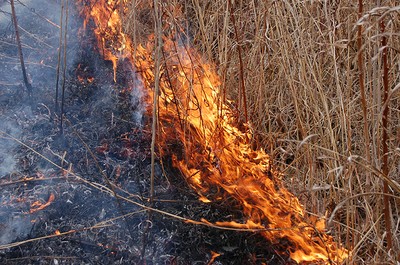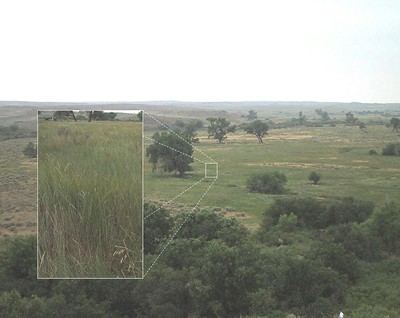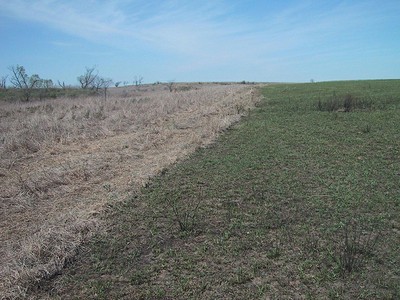Historic Images of Heterogeneity
Native Americans were well adapted to the use of fire. Extensive areas across the entire Great Plains burned every three to seven years, with some areas burning twice in the same year.
Photo by Stephen Winter
Heterogeneity refers to the differences in habitats across the landscape, and is required for diverse plant and wildlife communities. Some heterogeneity is inherent, caused by differences in soils, while most heterogeneity is disturbance driven. Climate, fire, and grazing are the main three disturbance factors that have historically shaped the landscape. All three are still very important to the continued diversity and health of the plants and animals associated with our prairies, shrublands, and forest lands across the Great Plains. While we cannot control the climate, we can manage grazing by stocking rate, season of use, and kind, and type of animal. Fire can also be managed by frequency, season, and weather conditions. To keep biodiversity intact, these disturbances should be considered collectively, rather than independent of each other.
Fire was so important in the maintenance of grasslands and savannas that one of the Native American tribes from the northern plains used the same word for both “prairie” and “fire”. Numerous historical accounts of frequent fires across the entire Great Plains can be found to substantiate its importance to the plants and animals of the region. These areas burned every three to seven years, with some areas often burning twice in the same year. In the autumn of 1832, Washington Irving described the land in “Indian Territory” as: “The grass is at times green and short and at other times tall and white…nothing but bare prairie, which becomes confused in the distance with the smoke of burning grass.” This describes a landscape of burned and grazed (green and short) areas (we call “burned patches”), along with areas of ungrazed and unburned grass (tall and white) (we call “unburned patches”)--a verbal picture of a heterogeneous landscape.
Landscapes (i.e. Tallgrass Prairie) > Communities (i.e. upland site) > Patch (i.e. burned area) > Feeding Station (i.e. site within burned area) > Plant (i.e. Indiangrass) > Plant Part (i.e. leaf).
From historical fire and grazing patterns we know that animals preferentially select burned areas and graze them heavily. When another area was burned, they shift their utilization to this new patch. This allows the previously burned and closely grazed patch to rest until adequate fuel has grown back, which allows the next fire event. This fire-grazing interaction would create a shifting mosaic over the entire landscape that was critical to the conservation of biodiversity.
Caption: Grazing distribution and habitat selection by feeding animals is determined by decisions made at multiple levels: Landscapes (i.e. Tallgrass Praire) > Communities (i.e. upland site) > Patch (i.e. burned area) > Feeding Station (i.e. site within burned area) > Plant (i.e. Indiangrass) > Plant Part (i.e. leaf). From historical fire and grazing patterns we know that animals preferentially select burned areas and graze them heavily. Photo by Samuel D. Fuhlendorf.
Caption: In the autumn of 1832, Washington Irving described the land in “Indian Territory” as: “The grass is at times green and short and at other times tall and white…nothing but bare prairie, which becomes confused in the distance with the smoke of burning grass.” This is a verbal picture of a heterogeneous landscape. Photo by Stephen Winter.
Most grazing management promotes uniform distribution and utilization, which creates homogenization of the vegetation. These practices include uniform distribution of focal attractants (i.e. water, salt, mineral), prescribed fires that burn the entire management unit, and application of fertilizers and herbicides. The most effective homogenization practice is grazing systems, especially rotational grazing. Rotational grazing reduces diversity of plant communities and wildlife species, and despite popular contrary claims, rotational grazing also reduces livestock production and net return/acre by forcing livestock to graze equally across all areas of a pasture.
Traditional approaches to grazing overlook the potential benefits of coupling fire and grazing. Most often, grazing is the only practice used, and often to the point of over utilization. Conversely, if fire is used by a land manager, it is normally implemented with deferment of grazing before and after the fire. Rarely are these two ecosystem drivers used together as they occurred historically on native prairies.



